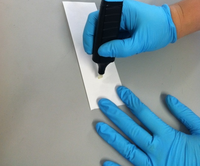








A marker pen, fineliner, marking pen, felt-tip marker, felt-tip pen, flow, marker or texta (in Australia) or sketch pen (in India), is a pen which has its own ink-source, and usually a tip made of porous, pressed fibers such as felt.A typical permanent marker consists of a container (glass, aluminum or plastic) and a core of an absorbent material. This filling serves as a carrier for the ink. The upper part of the marker contains the nib that was made in earlier time of a hard felt material, and a cap to prevent the marker from drying out. Until the early 1990s the most common solvents that were used for the ink were toluene and xylene. These two substances are both harmful and characterized by a very strong smell. Today, the ink is usually made on the basis of alcohols (e.g. 1-propanol, 1-butanol, diacetone alcohol and cresols).
History
The felt-tip pen was invented by Sidney Rosenthal in 1953. This inventor from Richmond Hill, New York, placed a felt tip on the end of a small, stout bottle of permanent ink and discovered that the resulting marks saturated a heavy, absorbent surface, yielding rich color and permanence.
The felt-tip pen had many predecessors. Inks and dyes have been used throughout human evolution for marking objects, from cave writings fashioned from natural dyes of the earth applied with sticks to graffiti applied with paint from an aerosol can. Ink is a combination of a coloring agent, or pigment, and a liquid containing oils, resins, and chemical solvents. Initially, ink was fashioned from different colored juices and plant and animal extracts. Today, synthetic materials are used in addition to these natural substances.
The use of ink for writing and printing dates back to 3,200 b.c., when the Egyptians used a mixture of fine soot and vegetable gum to create a substance that could be used for writing and painting. Both Egyptians and Greeks used iron oxide (or, more commonly, rust) to make red ink. Around 2,000 b.c., the Chinese began making red ink from mercury sulfate and black ink from iron sulfur mixed with sumac tree sap. Like the Egyptians, they formed their ink into a solid block or stick that would be mixed with water when used. Europeans did not begin commonly using ink until the seventeenth century, using tannic acid from tree bark and iron salt to create the recipe that formed the blue and black inks still used today.
Like inks and dyes, pens have been used since antiquity. The earliest pens were made from hollow reeds and, later, hollow wing feathers of geese and swans, called quills, infused with ink. Steel pen nibs came into use in the early 1800s, and then fountain pens, which did not require a constant resupply of ink like previous incarnations, gained popularity.
House paint also came into popular use in the late 1800s when Edwin Binney and Harold Smith used red oxide pigments (a mixture of naturally occurring dyes and chemicals) to create a viscous coloring substance—the paint that was used to color America's first classic red barns. Binney and Smith, through their company Binney & Smith, then created a line of carbon black pigments that were used by the Goodrich company to color its white auto tires black.
Next, Binney & Smith acquired a water-powered stone mill in Easton, Pennsylvania, and began fashioning slate culled from the area into pencils. From there, the company created dustless chalk in 1902. In 1903, the company fashioned a variant of its industrial wax marking crayons, which were smaller and came in a variety of colors created by colored pigments added to paraffin wax. Thus, Crayola crayons were born.
By the late 1950s while Binney & Smith was expanding its crayon business, Rosenthal was building up his company, Speedry Chemical Products, which manufactured and marketed his felt-tip pen invention. Rosenthal initially geared his product at the art supplies market, but soon thought to capitalize on its mass market appeal due to its suitability to poster-making, sign-lettering, and other marking purposes. Competitors threw their hats in the ring as early as 1958, when Carter's, Inc., came out with a more slender marker with an aluminum ink tube. Speedry sued Carter's for patent infringement, but lost. Other companies began marketing pens containing water-soluble inks that could be used on normal-weight paper (Rosenthal's invention required heavier paper to keep the ink from soaking straight through to the underlying surface) and with capillary flow technology, which enhanced the movement of the ink into the tip of the writing utensil. When Rosenthal changed the name of his company to Magic Marker Corporation in 1966, he was already suffering the effects of this increased competition.
Despite its name becoming synonymous with its product, regardless of the manufacturer, Magic Marker Corporation continued to lose money and filed for bankruptcy in 1980. In 1989, Binney & Smith, now a subsidiary of the Hallmark Corporation, purchased the rights to the Magic Marker name, stating that it was motivated to purchase the moniker due to remaining high consumer recognition of the brand name. The defunct Magic Marker Industries would be able to use the royalty income garnered from selling the use of its name to pay off creditors. Binney & Smith now manufacturers a wide variety of Crayola markers as well as Magic Markers.